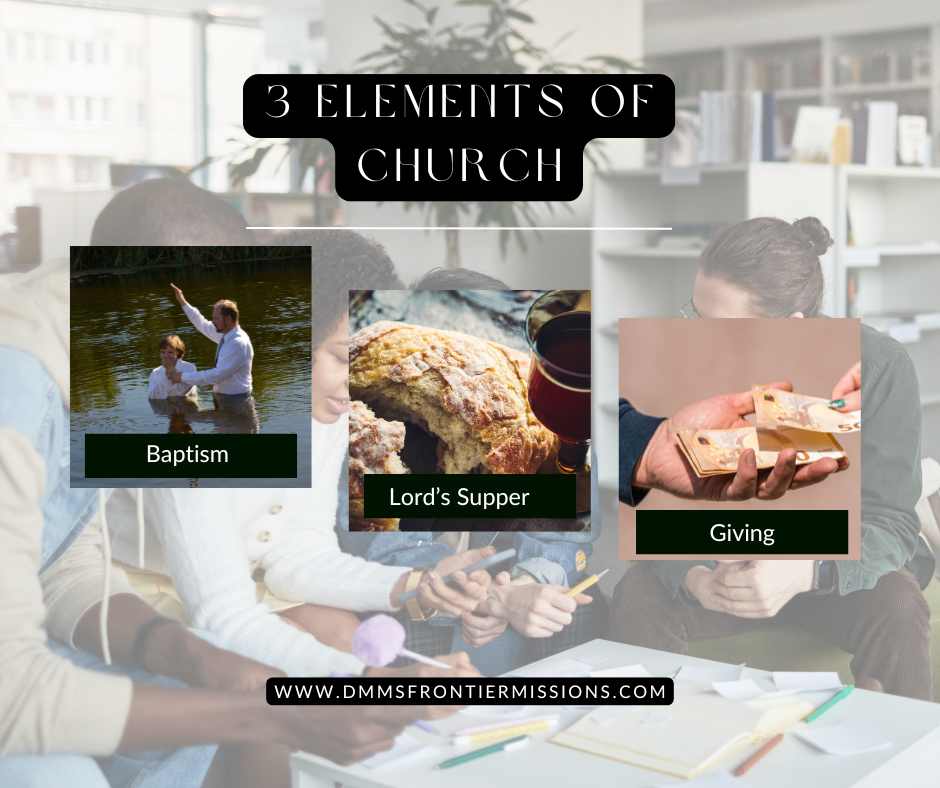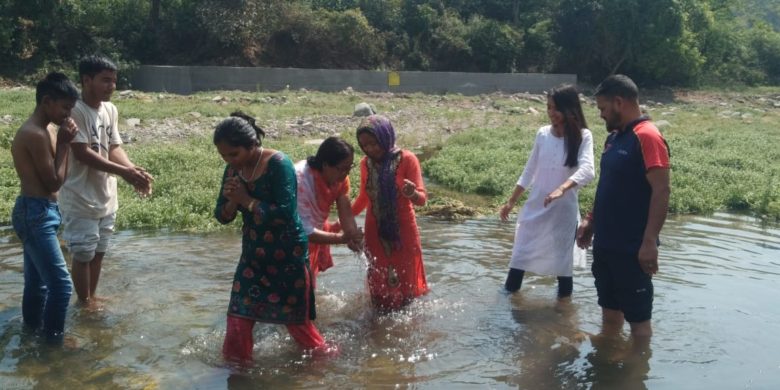Many people willing to come to a discovery home group would never enter a church building. As a devout Muslim, they may be afraid of what their relatives would say if they saw them go to a “church.” Or maybe they had a bad experience with church or Christians in the past. Most people want to know God, but many have little interest in organized religion. As we offer friendly environments for people to discover more about Jesus, there comes a point when the group solidifies, people have believed, and been baptized. At that stage, we need to know how to introduce the concept of church.
This is important in launching a Disciple Making Movement. After people have committed to following Jesus, we want to move them gently toward becoming a functioning, healthy, body of believers.
This article is Part 1 in a series on how to transition your discovery or story group into a church.
What Makes a Church a Church?
If you haven’t yet read my free e-book called “What Makes a Church a Church?” I’d encourage you to do that! You can get it free here. As DMM practitioners, we need to have a biblical understanding of the church.
In some contexts, you may not even call your group a church if that has a negative connotation in the culture[1]. Even so, it is important that the groups take on the biblical function of the church and see themselves as such.
In my last article, I wrote about calling people to commitment. Once people say “yes” to following Jesus as an obedient disciple, you are on your way to becoming a church.
A Living Organism
One of my friends, Bill S. wrote the following. “A Bible study group becomes a church when a people dead in sin become, through faith in Jesus Christ, a living organism characterized by a Christ-sustained ability to govern, support, and propagate itself. The act of baptism is the mark of allegiance to Christ and of a special church family relationship.”
As Bill says, “Baptism is a key step toward seeing the group begin to function as a church. Don’t delay baptism for a long time. If people have accepted Christ’s gift of salvation and repented of their wrong-doing, go ahead. Baptize them. Also, teach them about becoming part of the family of God- the church. It is important to cover what the church is, and what are its functions.”
A Church is Born
“Today, this group becomes a church!” I declared as we began the baptism ceremony at the river. I’d spent a bit of time the week before helping them understand what we meant by the word church. We were not talking about a building, but about functioning together as the family of God. We would be part of one body, with Jesus as the head.
It was an exciting day as that first church was born! My role was as a mid-wife to this process. The church was theirs, not mine.
We joyfully baptized four people in the nearby river. On the short drive back to the home of one of those who’d taken this step, we sang songs of praise to Jesus. Smiles beamed off the faces of these new followers of Christ. My grin was very broad as well. I was overwhelmed with joy.

Reaching the person’s home, everyone sat in a circle on the floor. We had a brief time of worship. One of the ladies went into the kitchen. She prepared a chapati (flat bread) and red tea that we would use to celebrate the Lord’s supper together. Placing it on a simple tin plate, she covered the cup and chapati with a cloth. The tea was hot, so we needed to let it cool a bit.
“Let’s read again about the very first time Jesus ever did this special ceremony,” I said. We opened our Bibles and I told the story of the Last Supper. Everyone in the group repeated the story back until they could say it accurately. We then discussed it using the discovery questions: What do we learn about God? What do we learn about people? What do we need to obey?
It was clear to all that Jesus had commanded us as His followers to “Do this in remembrance of Him.” As we too celebrated this way, we were following Jesus’ example. From now on, we would regularly take part in this ceremony together.
I then led us in a time of silent prayer, asking if there was anything we needed to ask God’s forgiveness for. Our hearts needed to be clean. A few prayed out prayers of confession, asking God for forgiveness for things they had done that week. We thanked Jesus for dying on the cross, so we could be cleansed of sin. Then, we took the cup and bread, prayed over them and took them together.
It was a simple ceremony but full of meaning for everyone. I went home that day with a happy heart. A new church had been born! I was confident that in the coming months, this church would multiply. These disciples would lead others to faith. This same process would be repeated in many new locations.
“For I received from the Lord what I also delivered to you, that the Lord Jesus on the night when he was betrayed took bread, and when he had given thanks, he broke it, and said, “This is my body, which is for you. Do this in remembrance of me.” 1 Cor. 11: 23-24 NIV.
3 Aspects of the Church
If you are using Ying Kai’s T4T Baby Lessons, lesson 4 is about the Church- Your Spiritual Family. You can cover this using these lessons or using a Discovery Bible Study set. Be sure to include studies about the nature of the church in your long-term discipleship plan.
1. What the Church Is
The Bible uses many metaphors to describe the church (the Greek word is ecclesia). Two of the most helpful are 1) the church as a family (1 Cor. 1:9-10) 2) the church as a body (Rom. 12:4-5). It is important to help the disciples to understand that the church is not a building or a place. It is us! We, the followers of Jesus, are the church.
2. How the Church Functions
The church functions together as a body. Each member does their part and uses their own spiritual gifts. You may want to introduce that idea now, and then come back to do further study on spiritual gifts in the future.
Some of the activities of the church are: worship, fellowship, teaching, ministry to one another and the lost, spreading the gospel.

3. Baptism, Lord’s Supper and Giving
As mentioned above, the church is born when you baptize the first disciples. We then encourage you to also begin to celebrate the Lord’s Supper and practice regular giving. Here is a good article on generosity in the church. A practical way to introduce these three church functions is to do a study on Acts 2:42-47.
The e-3 partners training manual called Disciples Making Disciples, includes this in the section on Field 4: Harvest Field – Become a Church. They suggest asking trainees/disciples to discuss what does God do and what do the disciples do in this passage. As the new believers discover from God’s Word how the early church functioned, they will want to do the same.
A Time to Celebrate
Transitioning your discovery or story group into a church is an exciting step to take. Celebrate it! Plan for it from the beginning. Though you may not mention that you are starting a church, prepare with that goal in mind. Remember, the church is not a building. Please don’t install a pastor and put up a signboard and pulpit! Keep it simple so it will rapidly multiply.
What questions do you have about transitioning a discovery group into a house church? Comment below or post them on the DMMs Frontier Missions (soon to become Dare to Multiply) Facebook group or page.
[1] In some places among Hindus we call these churches satsangs. Or among Muslims we use the term jamat.




Comments
How much time it took for you to do a dbs with these four people until a point where you got to baptise them?
Author
We try to baptize as soon as possible after the believe and show sign of repentance. It can happen in a day or a few weeks or for some it takes a bit longer as they explore and discover Jesus and what it means to become his follower.
Hello I am very interessed to study bible
Pingback: A Multiplication Dream Among Africa's Refugees - YWAM Frontier Missions
May God’ presence continue to be with you as you do his work.
The lesson is good by God grace I learn something about planting a church. with your teaching,
Be blessed
I’m the folloer of Jesus Christ and I’m believe that Jesus Christ is son of God Father. I’m believe in God Father and his Son and holy spirit
The lessons are good for church planting
By God’s grace everyone will see to be part of the family and will participate as a member in the body of Christ.
The lesson is so amazing I like it, and I have also learned a lot of things about church.
Powerful message God bless you
Powerful message